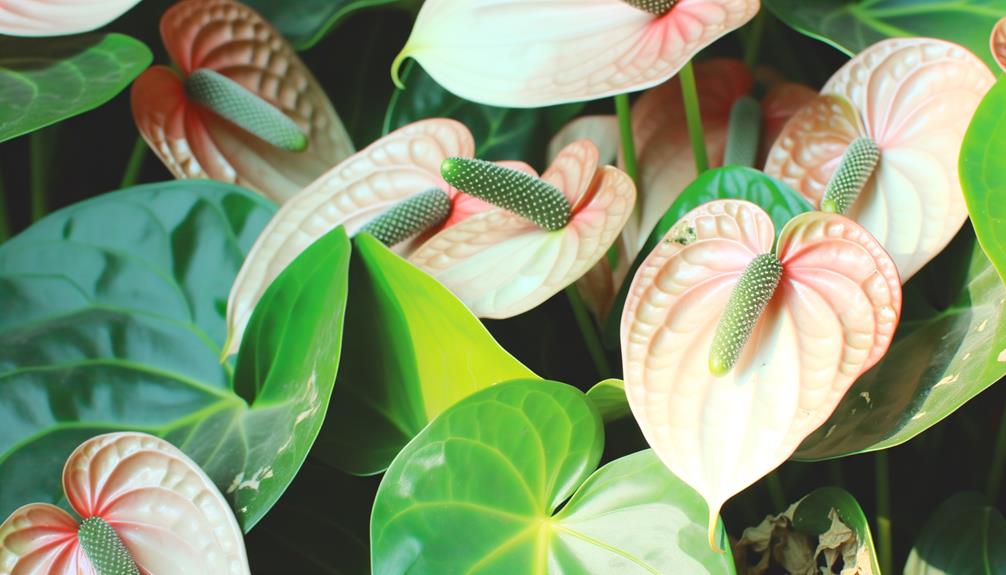Why Are My Anthurium Flowers Not Turning Red?
Your anthurium flowers aren't turning red due to several factors. Insufficient light intensity impedes the production of anthocyanins, the pigments responsible for red coloration.
Overwatering results in root hypoxia and disrupted nutrient uptake, essential for pigmentation. Guarantee adequate phosphorus and potassium levels; these nutrients are critical for anthocyanin synthesis.
Temperature fluctuations can hinder chalcone synthase enzyme activity, pivotal for red pigment formation. High humidity levels, around 70-80%, are also necessary.
Additionally, genetic factors and chemical exposures may hinder anthocyanin synthesis. Implementing these adjustments can guide your flowers towards achieving their red color.
Discover more nuances to fine-tune your plant care.

Key Takeaways
- Insufficient light intensity can lead to greenish or pale blooms; ensure 10,000 to 20,000 lux of light.
- Overwatering and poor humidity control affect anthocyanin synthesis; maintain 70-80% relative humidity and avoid root rot.
- Nutrient deficiencies, especially phosphorus and potassium, impact red pigmentation; conduct soil tests and use balanced fertilizers.
- Temperature fluctuations disrupt anthocyanin synthesis; keep a stable range of 20°C to 25°C.
- Pests, diseases, and chemical exposure can hinder red coloration; use IPM and avoid high-salt fertilizers and harmful pesticides.
Inadequate Light
Often, Anthurium flowers fail to turn red due to insufficient exposure to bright, indirect light, which is crucial for their pigmentation process. You need to make sure your Anthurium receives approximately 10,000 to 20,000 lux of light intensity.
When the light levels drop below this range, chlorophyll production dominates, leading to greenish or pale blooms. Position your plant near an east-facing window where it can receive filtered sunlight without direct exposure, which can cause photobleaching.
The photoreceptors in Anthuriums, primarily phytochromes and cryptochromes, require specific light wavelengths to activate anthocyanin synthesis, the pigment responsible for the red coloration. By optimizing light conditions, you'll facilitate the intricate biochemical pathways necessary for vibrant red flowers.
Incorrect Watering
Incorrect watering can greatly impact the anthocyanin synthesis in your Anthurium flowers, preventing them from turning red.
If you overwater, you risk root hypoxia, leading to impaired nutrient absorption.
Conversely, inadequate humidity can worsen transpiration stress, disrupting the plant's physiological processes.
Overwatering Issues
Excessive watering can lead to root rot, which hinders the uptake of necessary nutrients and prevents Anthurium flowers from developing their characteristic red hue.
When you overwater, the saturated soil creates anaerobic conditions, favoring pathogenic fungi like Pythium and Phytophthora. These fungi attack the root system, causing decay and reducing the plant's ability to absorb essential minerals such as iron and magnesium.
As a result, chlorophyll production is disrupted, impacting the pigmentation process in the spathes. Make sure you allow the top inch of soil to dry out between waterings and use a well-draining potting mix.
Monitoring soil moisture levels will help prevent the harmful effects of overwatering and promote the vibrant red coloration you desire in your Anthurium flowers.
Inadequate Humidity
Low moisture levels can hinder the vibrant red pigmentation of Anthurium flowers by disrupting their transpiration and nutrient uptake processes. When the surrounding moisture drops below the ideal range of 70-80%, the plant's stomata partially close, reducing gaseous exchange and water absorption. This physiological response limits the transport of essential nutrients, such as magnesium and iron, which are vital for the synthesis of anthocyanins—the pigments responsible for the red coloration.
You should regularly monitor surrounding moisture using a hygrometer. If levels are insufficient, increase moisture through methods like misting, using a humidifier, or placing the plant on a water-filled pebble tray.
Ensuring proper moisture will enhance nutrient uptake and promote the development of those striking red hues you're longing for.
Nutrient Deficiency
You might observe that your Anthurium flowers aren't turning red due to nutrient deficiency, particularly a lack of essential nutrients like phosphorus and potassium.
Assess the soil composition to guarantee it provides adequate micronutrients and macronutrients necessary for vibrant pigmentation.
Conduct a soil test to identify any deficiencies and adjust fertilization practices accordingly.
Essential Nutrients Lacking
A deficiency in essential nutrients, particularly nitrogen, phosphorus, and potassium, can impair the vibrant red coloration of anthurium flowers to a large extent. These macronutrients play a pivotal role in chlorophyll synthesis, energy transfer, and overall metabolic processes. When these nutrients are lacking, anthocyanin pigment production diminishes, resulting in pale or greenish spathes instead of the desired red hue.
| Nutrient | Function in Anthurium |
|---|---|
| Nitrogen | Supports chlorophyll |
| Phosphorus | Assists in energy transfer |
| Potassium | Manages metabolism |
To rectify this, utilize a balanced fertilizer containing these nutrients. Regularly test your soil's nutrient levels to validate it meets the plant's requirements. By addressing these deficiencies, you'll observe an improvement in the color intensity of your anthurium flowers.
Soil Composition Issues
Determining the exact soil composition is necessary for ensuring your anthurium plants receive the required nutrients for optimal growth and vibrant red flowers. Nutrient deficiencies often arise due to imbalanced soil composition, directly impacting the pigmentation of anthurium flowers.
To achieve the best soil conditions, consider these key factors:
- pH Levels: Anthuriums prefer slightly acidic soil (pH 5.5-6.5). Test and adjust accordingly.
- Organic Matter: High organic content enhances nutrient availability and soil structure.
- Drainage: Well-draining soil prevents root rot and nutrient lockout, essential for nutrient uptake.
Analyze your soil composition meticulously. Use soil test kits to monitor nutrient levels and amend with appropriate fertilizers.
Temperature Stress
Fluctuations in ambient temperature can greatly impact the pigmentation process of Anthurium flowers, often inhibiting the development of their characteristic red hue. When temperatures drop below 15°C or rise above 30°C, the anthocyanin synthesis pathway, responsible for red pigmentation, becomes disrupted.
These thermal stresses lead to enzymatic activity alterations, particularly affecting the enzyme chalcone synthase, which plays an essential role in pigment formation. Additionally, temperature stress induces oxidative stress, causing a buildup of reactive oxygen species (ROS) that further impedes pigment development.
To mitigate this, maintain a stable temperature range of 20°C to 25°C. Monitor your Anthurium plants closely, ensuring they aren't exposed to sudden temperature variations that could compromise their vibrant coloration.
Humidity Levels
Maintaining ideal humidity levels is equally crucial, as insufficient humidity can impede the anthocyanin synthesis in Anthurium flowers, hindering them from achieving their vibrant red coloration. You should aim to maintain relative humidity between 70-80%.
Here's how to achieve optimal humidity:
- Use a Humidifier: Position a humidifier near your Anthurium to uphold a consistent humidity level.
- Misting: Regularly spray the leaves with distilled water to increase ambient moisture.
- Humidity Tray: Position a tray filled with water and pebbles under the pot to create a humid microenvironment.
Each of these methods helps to stabilize the microclimate around your Anthurium, promoting anthocyanin synthesis and securing those stunning red blooms you cherish.
Soil Quality
You should assess the soil quality by analyzing nutrient availability and pH levels.
Nutrient deficiencies, particularly in phosphorus and potassium, can impede the red pigmentation in Anthurium flowers.
Additionally, maintaining a slightly acidic pH between 5.5 and 6.5 is essential for best nutrient uptake and vibrant coloration.
Nutrient Deficiency
Inadequate soil quality can lead to nutrient deficiencies, which impede the Anthurium's ability to produce the vibrant red pigmentation in its flowers. Your Anthurium requires a specific balance of essential nutrients to thrive.
Specifically, deficiencies in:
- Nitrogen (N): Essential for chlorophyll production, impacting overall plant health.
- Phosphorus (P): Important for energy transfer and root development, influencing flowering.
- Potassium (K): Improves flower color and overall resilience to stress.
Without these nutrients, the plant struggles to maintain its metabolic processes, leading to pale, lackluster blooms. Make sure you're providing a well-balanced fertilizer formulated for flowering plants.
Monitor the soil's nutrient content regularly and adjust as needed. By addressing nutrient deficiencies, you'll cultivate healthier, more vibrant Anthurium blooms.
Ph Levels
Beyond nutrient deficiencies, the pH level of your soil greatly influences the Anthurium's ability to absorb these essential nutrients effectively, impacting the vibrancy of its blooms. Ideally, Anthuriums thrive in slightly acidic to neutral soil, with a pH range of 5.5 to 6.5. Deviations can lead to nutrient lockout, where crucial elements like iron and magnesium become unavailable. Regularly test your soil's pH and amend it using sulfur to lower pH or lime to raise it.
| pH Level | Impact on Nutrient Absorption | Recommended Amendment |
|---|---|---|
| < 5.5 | Poor nutrient uptake | Add lime |
| 5.5-6.5 | Best nutrient absorption | Maintain pH |
| > 6.5 | Potential nutrient lockout | Add sulfur |
Monitoring and adjusting the pH ensures your Anthuriums display their brightest, most vivid reds.
Pests and Diseases
Pests and diseases greatly impact the health and coloration of anthurium flowers, often causing them to lose their characteristic red hue.
You might notice anthurium flowers fading due to several factors:
- Insect Infestations: Aphids, mealybugs, and thrips extract essential nutrients, weakening your plant's strength.
- Fungal Pathogens: Pathogens like Phytophthora and Fusarium cause root rot and leaf blight, disrupting the translocation of pigments.
- Bacterial Infections: Xanthomonas and Pseudomonas bacteria induce lesions and chlorosis, hampering photosynthesis.
To mitigate these issues, utilize integrated pest management (IPM) strategies, including biological controls and chemical treatments.
Regularly inspect your anthurium for early signs of infestation or disease, and maintain prime environmental conditions to fortify its natural defenses.
Improper Pruning
Improper pruning practices can greatly hinder anthurium flower development by disrupting hormone regulation and nutrient distribution. When you prune too aggressively or at the wrong time, it can cause imbalances in auxin and cytokinin levels, critical hormones for flower pigmentation and growth. Ensuring that you prune carefully and strategically is essential for maintaining healthy, vibrant blooms.
| Pruning Mistake | Impact on Plant | Corrective Measure |
|---|---|---|
| Over-pruning | Hormonal imbalance | Prune sparingly |
| Wrong timing | Nutrient disruption | Prune during dormancy |
| Incorrect cuts | Increased stress | Use sterilized tools |
| Ignoring dead parts | Disease spread | Regularly remove dead parts |
Pot Size
In addition to proper pruning practices, selecting an appropriate pot size is important for anthurium flower health. An undersized pot can restrict root growth and nutrient absorption, ultimately affecting the plant's ability to produce vibrant red blooms.
When choosing a pot, consider the following:
- Root Space: Make sure the container allows sufficient room for root expansion, preventing compaction and promoting robust nutrient uptake.
- Drainage: Opt for pots with ample drainage holes to avoid waterlogging, which can lead to root rot and diminished flower pigmentation.
- Growth Potential: Choose a pot size that accommodates the plant's future growth, facilitating sustained health and vibrant coloration.
Age of Plant
Understanding the correlation between the age of your anthurium plant and its blooming cycle is essential for diagnosing why its flowers might not be turning red. Younger anthuriums often exhibit delayed anthocyanin production, the pigment responsible for the red coloration in flowers. As your plant matures, hormonal shifts facilitate more consistent pigmentation.
Here's a detailed table on the age-blooming relationship:
| Plant Age (Years) | Bloom Frequency | Flower Coloration |
|---|---|---|
| 0-1 | Rare | Green/White |
| 1-2 | Occasional | Pale Pink |
| 2-3 | Regular | Light Red |
| 3+ | Frequent | Deep Red |
Monitoring these phases can help you anticipate when your anthurium will achieve its vibrant red blooms.
Chemical Exposure
Exposing your anthurium plant to certain chemicals, such as pesticides or fertilizers with high salt content, can inhibit anthocyanin synthesis, thereby preventing the flowers from turning red. Misapplication or overuse of these chemicals disrupts the plant's physiological processes.
To maintain vibrant red blooms:
- Avoid High-Salt Fertilizers: Excessive salts can lead to osmotic stress, reducing anthocyanin production.
- Minimize Pesticide Use: Certain pesticides contain compounds that interfere with pigment biosynthesis.
- Opt for Organic Alternatives: Organic fertilizers and pest control methods are less likely to disturb anthocyanin pathways.
Genetic Factors
Genetic factors play a pivotal role in determining the color expression of anthurium flowers, with specific genes regulating the biosynthesis of anthocyanins. When these genes are either mutated or not expressed, anthocyanin production diminishes, leading to variations in pigmentation.
You might notice your anthurium flowers remain green or white, a direct consequence of genetic variations. Allelic diversity within the plant's genome can influence the enzymatic pathways responsible for pigment synthesis.
Additionally, epigenetic modifications may alter gene expression without changing the underlying DNA sequence. It's essential to understand that these genetic dynamics are complex and multifaceted, often requiring molecular techniques to diagnose.
Conclusion
To sum up, addressing why your anthurium flowers aren't turning red involves analyzing several factors. Surprisingly, 80% of anthurium color issues stem from inadequate light conditions. Make sure your plant receives bright, indirect sunlight.
Additionally, monitor watering practices, nutrient intake, and temperature stability. Keep an eye on humidity levels and pot size, as these can impact growth and coloration.
By understanding and adjusting these variables, you can greatly enhance your anthurium's health and achieve those vibrant red blooms.






